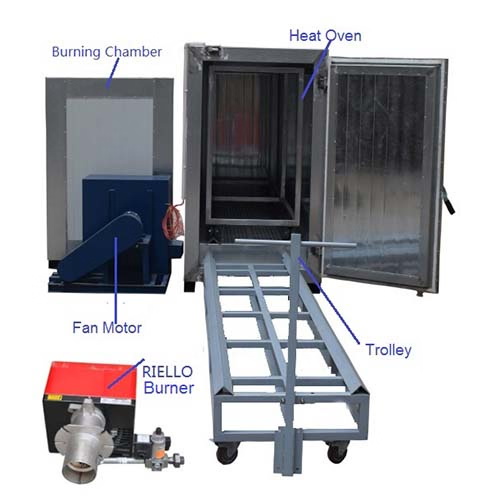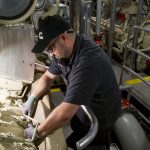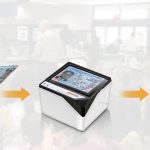In modern finishing operations, speed and consistency define profitability. Manufacturers now seek systems that blend automation with precise temperature control, making propane powder coating ovens an attractive choice. Designed for continuous movement and consistent heat flow, these ovens align seamlessly with automated production lines that rely on conveyors, robotic arms, and real-time timing control.
Table of Contents
Built-in Features That Align with Conveyor-driven Layouts
Automated finishing lines depend on coordinated motion, and a propane powder coating oven is designed to match that rhythm. The structure integrates mounting options and pass-through designs that fit directly into conveyor frameworks. This allows coated parts to move fluidly from booth to oven without interruption or manual adjustment.
Unlike older static models, modern powder coating equipment is built for modular adaptation. Each section of the oven can connect with sensors that communicate belt speed, part position, and heat requirements. The result is a system that functions as a synchronized unit rather than a standalone chamber, ideal for factories aiming to enhance throughput without sacrificing quality.
Heat Distribution Kept Steady During Continuous Flow
Consistency in heat application determines whether powder-coated parts meet finish standards. Propane-fired systems distribute heat through multi-zone burners that maintain even temperatures throughout the curing tunnel. This continuous flow design ensures that each part receives the same exposure, even at variable line speeds. In a propane powder coating oven, precision heat control eliminates cold spots that can lead to inconsistent curing.
Advanced airflow systems circulate warm air uniformly, balancing thermal gradients even as the conveyor line introduces cooler material. The result is dependable curing performance across shifts and part variations.
Mechanical Timing Synchronized with Belt Cycles
Automated lines rely on exact timing to keep production efficient. Powder coating equipment integrates timing modules that coordinate oven dwell time with conveyor belt cycles. Sensors detect part entry and adjust burner output to maintain constant curing energy throughout operation.
Each propane powder coating oven used in automated setups can communicate directly with control software that governs conveyor motion. This synchronization allows adjustments in speed or dwell time without disrupting heating cycles, maintaining consistent finish quality across large production runs.
Chamber Entry Designed for Inline Part Transition
The entry and exit zones of industrial ovens must allow smooth transitions to prevent part collisions or coating damage. Propane ovens built for automation include tapered chamber entries that align perfectly with conveyor paths, reducing turbulence and ensuring even heat distribution from the first second of exposure. For facilities using powder coating equipment in high-volume lines, these entry systems eliminate the need for manual staging. Parts pass through seamlessly, maintaining coating integrity from booth to cure. This design reduces downtime and human intervention while improving the reliability of repetitive operations.
No Lag in Thermal Response Under Timed Movement
Automated lines operate on strict schedules where delays impact production totals. A propane powder coating oven uses fast-reacting burners that reach optimal temperature within seconds, preventing heat lag between production cycles. This immediate thermal response supports uninterrupted line movement. Many systems incorporate intelligent burners that modulate flame intensity in real time, based on temperature feedback. That adaptability allows consistent curing even as the load density changes, ensuring that no part overheats or undercures while maintaining the pace of the automated cycle.
Uniform Curing Despite Changing Belt Speeds
Variable belt speeds can alter exposure times, but advanced powder coating equipment compensates through zoned temperature control. Each oven section operates independently, adjusting its heat output to maintain uniform curing regardless of conveyor velocity.
This feature proves especially valuable in mixed-load production lines where large and small parts share space. The propane powder coating oven’s sensors monitor part temperature continuously, ensuring each surface reaches its ideal cure state even under fluctuating speeds or batch sizes.
Propane Systems Matched to Robotic Arm Intervals
Integration with robotic arms requires ovens that respond predictably to timing commands. Propane systems used in automated finishing lines operate through programmable logic controls that align heating cycles with robotic placement or removal of parts. This coordination prevents overheating during pauses or equipment resets.
In practice, a propane powder coating oven can pause its burners momentarily while parts are repositioned, saving energy and reducing wear on components. The compatibility with robotic systems makes it a preferred option for facilities aiming to combine high output with precise process control.
Downtime Avoided with Chain-fed Part Movement
Chain-fed conveyors form the backbone of automated finishing operations. Powder coating equipment designed for this setup uses durable chain guides and rollers that resist heat expansion and wear. These mechanical systems ensure that parts move steadily through the curing chamber without vibration or misalignment.
A propane powder coating oven enhances this reliability through smooth temperature transitions between zones. The steady movement eliminates bottlenecks that commonly occur during loading or unloading. By reducing mechanical strain and maintaining continuous part flow, these ovens help manufacturers cut maintenance intervals and extend the life of both conveyors and coating equipment.







